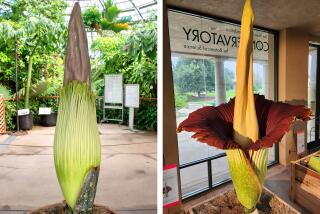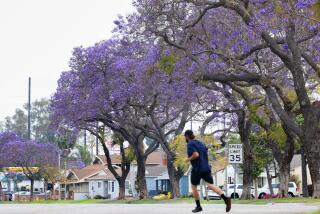Unexpected Return of a Big Stinker
- Share via
What, they’re lining up again to see the huge, stinky blooms of Amorphophallus titanum, “the world’s largest flower”? I thought this rare plant seldom bloomed, that the last time it flowered, in August 1999 at the Huntington Botanical Gardens in San Marino, was only the 11th time in the U.S. since its discovery in Sumatra in 1878--a once-in-a-lifetime event.
It’s the same plant that’s blooming this time around, and it appears that it may flower every three to seven years, though flowering has been such a rare enough occurrence that no one is sure. “It’s becoming more frequent, but it’s still rare,” said Huntington curator John Trager. Last year the plant, also known as titan arum, bunga bangkai or corpse flower, bloomed at Fullerton Arboretum, and a few weeks ago one flowered at the University of Wisconsin. This has Trager hopeful that the Huntington can pollinate its plant this time around and get lots of little stinkers.
It is not easy to pollinate. Technically it does not have the “largest flower” because that huge, 6-foot-tall “flower” is actually an inflorescence, or composite flower, not a single blossom. There are in fact thousands of flowers, male and female, arranged spirally around the spadix, the fleshy central column. Last time the plant bloomed, the Huntington managed to get only five seedlings because the female flowers open before the males, so the plant cannot pollinate itself. While the female flowers were still open, Trager plucked off a few males and forced them to open early by putting them in a bag with rotting apples (which release a gas that triggers flowering).
But this time Trager has pollen from the Fullerton and Wisconsin plants, so he is hoping for lots of offspring. The Huntington would love to have loads of stinky plants in its new conservatory, set to open in 2004.
One of the seedlings from the last flowering is on display next to its parent, though mom is only 10 years old and “still a baby,” according to Trager. The bulb-like tuber it grows from weighs 36 pounds; mature plants have tubers that can weigh 160 pounds.
Everything about this plant is huge, hence the name. After it bloomed last time, it made one single leaf, but what a leaf it was. It lasted for three years and was 10 feet tall, with a stem 8 inches in diameter. After it fell off, the Huntington repotted the big tuber, but curators noticed a little rot near the base, so they briefly dried it out. Trager is not sure if this drying out or the starch built up by the humongous leaf is responsible for the quick reblooming.
The inflorescence came into full bloom Wednesday. It is expected to stay that way through today and will be on display through the weekend. You can be sure it will again raise a stink. That smell of rotting flesh is designed to attract the carrion beetles and dung beetles that pollinate the plant in the rain forests of Indonesia. Last time around, it was said you could smell it from half a mile away, but wouldn’t you rather stop and smell the roses that grow nearby?






